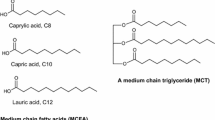Summary
Dichapetalum toxicarium seeds contain long chain fluoro-fatty acids, particularly fluorooleic acid, which in doses as low as 10 mg/kg can cause death. We have used the rat heart both in vivo and in vitro to assess the cardiovascular effects of various doses of the fluoro-oleic acid extract of the seeds ofDichapetalum toxicarium. Intraperitoneal administration of 0.25 ml of seed extract solution/kg body weight (estimated to be equivalent to 10 mg fluoro-oleic acid/kg body weight) or 0.5 ml/kg body weight (equivalent to 20 mg fluoro-oleic acid/kg body weight) resulted in death in all animals (n−6 in each group). The mean time from administration to death was 36.4±4 h and 21.0±2 h, respectively. Death was attributable to severe bradycardia which developed progressively throughout the experiment. Thus, during the first 6 h, heart rate fell by 32.2% from 450±7 beats/min to 305±36 beats/min (p<0.01) in the 0.25 ml/kg group and by 66±10% to 150±20 beats/min (p<0.001) in the 0.5 ml/kg group. Administration of the extract solution alone or oleic acid alone (equivalent to 0.5 ml/kg seed extract) to control rats had no effect. Investigating the effects of the seed extract in vitro, hearts (n=6 in each group) were perfused with buffer containing 0.5 ml/l seed extract (equivalent to 20 mg fluoro-oleic acid/l) or with buffer containing extract solution alone. In control hearts, there were no changes in heart rate or LVEDP over 150 min of aerobic perfusion; there were small declines in coronary flow, LVDP and LVdP/dtmax. Perfusion with seed extract resulted in a progressive decline in heart rate which, over the first 60 min of perfusion, fell by 53±7% from its control value of 323±11 beats/min to 153±20 beats/min (p<0.001). Similarly, significant declines in coronaryflow (fell by 53±12% over 60 min), LVDP (fell by 61±12% over 60 min) and LVdP/dtmax (fell by 63±7% over 60 min) were observed. LVEDP began to increase after 30 min and by 60 min had increased to 2.8±0.4 kPa (control value=0 kPa). Perfusion with oleic acid (20 mg/l) alone had no adverse effect on cardiac contractile function. Metabolic studies showed that the administration of the seed extract resulted in a loss of myocardial high energy phosphates. Thus, ATP and creatine phosphate fell from their control values of 20.6±0.4 and 27.8±0.6 μmol/g dry weight to 3.9±0.4 and 2.4±0.4 μmol/g dry weight (p<0.001 in each instance), respectively. Lactic acid content increased from 1.4±0.2 to 21.7±1.4 μmol/g dry weight (p<0.001). In conclusion, our results indicate that the fluoro-oleic acid-containing extract ofDichapetalum toxicarium exerts its toxic effects by severely reducing cardiac function. In vivo this can lead to death of the animal.
Similar content being viewed by others
References
Fallen EL, Elliott WC, Gorlin R (1967) Apparatus for study of ventricular function and metabolism in the isolated perfused rat heart. J Appl Physiol 22:836–841
Hall RJ (1972) The distribution of organic fluorine in some toxic tropical plants. New Phytol 71:855–863
Krebs HA, Henseleit K (1932) Untersuchungen über die Harnstoffbildung im Tierkörper. Hoppe-Seyler's Z Physiol Chem 210:33–66
Marais JSC (1944) Monolfluoroacetic acid, the toxic principle of “gifblaar” inDichapetalum cymosum. (Hook) Eng Onderstepoort J Vet Sci Anim Ind 20:67–72
Peters RA (1952) Lethal synthesis. Proc R Soc Lond B 139:143–151
Peters RA, Hall RJ (1959) Further observations upon the toxic principle ofDichapetalum toxicarum. Biochem Pharmacol 2:25–33
Peters RA, Hall RJ (1960) The toxicity to rabbits and some other animals of the fluoro-fatty acid present in the seed ofDichapetalum toxicarum. J Sci Food Agric 10:608–619
Peters RA, Hall RJ, Ward PFV, Sheppard N (1960) The chemical nature of the toxic compounds containing fluorine in the seeds ofDichapetalum toxicarum. Biochem J 77:17–22
Umbreit WW, Burris RH, Stauffer JF (1964) Preparation of Krebs Ringer phosphate and bicarbonate solutions. In: Manometric techniques. Burgess, Minneapolis, p 132
Author information
Authors and Affiliations
Rights and permissions
About this article
Cite this article
Tosaki, A., Hearse, D.J. Fluoro-fatty acids and the impairment of cardiac function in the rat in vivo and in vitro. Basic Res Cardiol 83, 158–166 (1988). https://doi.org/10.1007/BF01907270
Received:
Issue Date:
DOI: https://doi.org/10.1007/BF01907270




